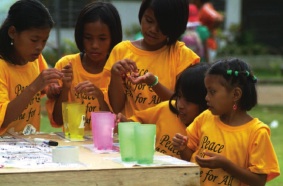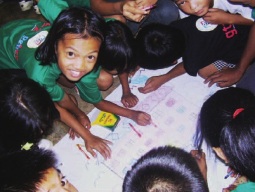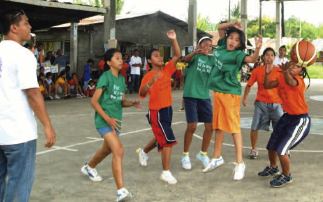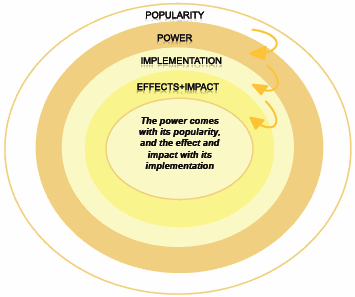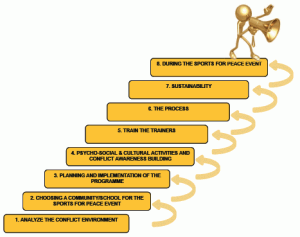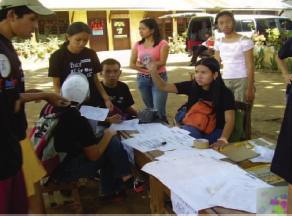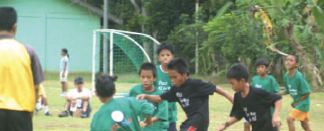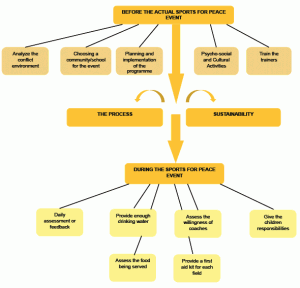Sports for Peace - Principles and General Procedures
|
|
Some Basic of Sports for PeaceSports programmes aiming to contribute to peace involve a clear understanding of different concepts/principles:
Photo 1 and 2: Workshops on the culture of peace
Photo 3: Principles and procedures: “Body and emotions”
Figure 1: From Popularity to Effects and Impacts
Focusing on mutual interest rather than using the problems as starting points for intervention, sport activities can create a neutral ground for interaction where communication can be restored and understanding and tolerance can be built provided one has acquired the adequate knowledge of the situation. This includes:
C. Choosing the students:
Main expected outcome:
|
|
|
Sports for Peace step-by-step approachThere are several different approaches using sport as a peace building method. The uniqueness of the Sports for Peace concept is the inclusion of the culture of peace, core values, the “marble theory” and children’s rights to support conflict transformation and peace building.
Figure 2: Step-by-step approach Step 1: Analyze the conflict environmentA thorough analysis of the conflict environment/context you plan to work in is vital in the conduct of a Sports for Peace event. The analysis would involve identification of the different conflict lines, the different actors and their relationships, development of the conflict and its present situation and how it would look like in the immediate future. A conflict map would be a useful tool for this exercise. The results of the conflict map and analysis would guide you in choosing the appropriate area/venue, activities, participants, etc. for the Sports for Peace event. A simple check list (see below) can also be a useful first step. |
 |
Simple checklist prior to conducting Sports for Peace:
Step 2: Choosing a community/school for the eventThe next step is the selection of the community/school you are willing to work in. A set of criteria agreed upon by all stakeholders is ideal to minimize biases as well as the feeling of inferiority by other communities/schools not selected. The criteria should provide a clear description of the community/ schools/participants to be chosen and the challenges being addressed by the Sports for Peace intervention.
Step 3: Planning and implementation of the programmeBefore the actual conduct of the Sports for Peace event, a sound, realistic and conflict sensitive plan should be developed. It is important to know that there is no substitute for a good plan but planning requires time, effort and much thought. A two-month lead-time is suggested considering the involvement of several stakeholders and the number of activities to be conducted on the ground. a) First, choose the date and venue. In choosing the venue and date, keep in mind that the time and place would be convenient for all stakeholders. The area to be chosen should be a consensus among the stakeholders wherein all could participate. It is accessible and should be conducive for the kind of activity to be conducted. b) Next task would be to inform the parents and the whole community about your planned programme and get the permission from the parents to let their children participate in the event. Throughout the whole Sports for Peace Event a participatory approach should be used and the community should be involved wherever possible. All people in the given community/school should be reached and involved in the whole process. Give each stakeholder tasks to do and include them right from the start (e.g. help setting up the venue on the date the event will take place; help giving out the sports items; support the teachers as team leaders etc.). Tap credible individuals in the community to organize your meetings and activities; actively solicit their involvement or participation. Their connections and standing in the community could work to your advantage and facilitate in achieving desired results. Keep them also updated of changes, achievements and further responsibilities along the way. c) You should decide if political leaders and/or heads of agencies are invited to grace the opening or the closing program. Out of courtesy give them ample time to work on their schedules and previous commitments to ensure their participation. Remember that these people are busy and some have peculiarities you should consider.
Photo 4: Planning for the implementation of the Sports for Peace event
f) Tap the services of the National Red Cross or similar entities in the area to provide medical assistance. Place first aid kits next to each playing field and place a responsible and trained person next to it. If possible get the Red Cross members on a voluntary basis. Consider the services of a media person if you intend to document the activities. If doing that, try to get journalists from different news agencies to be sensitive to different preferences and audiences. Get a caterer who can stick to the meal requirements (e.g. Muslims who only eat halal food) and knows the requirements of preparing that kind of meals.
Step 4: Psycho-social, cultural and conflict awarenessg) Regarding financial issues it would be an ideal set up to assign a national project staff to disburse and monitor the expenditures on site to ensure that cash advances are used for the items for which the amount is intended.
Photo 5: The tasks ahead
j) The participants are the prime consideration in choosing resource persons. Remember that in this case the participants are children whose span of focus and attention is limited compared to adults. With this consideration, the resource person should be able to adapt to the level of the participants. While mastery of the subject matter is desirable, the resource person should be sensitive to the issues and experiences of the participants. He or she should have the ability to capture and maintain the interest of the participants. Provide the resource person with a profile of the participants in advance (if this is possible) to help him or her develop topics effectively.
Step 5: Train the trainersIn some cases it could be better to use peer educators of different backgrounds and gender to ensure openness and interaction rather than a top-down approach as it would be with teachers. Even though this could be more difficult and time consuming, it would be good to “invest” in building an open and trustful atmosphere by doing so. The peer educators need to be trained in their specific tasks and the conditions they will be working in as well as in conflict sensitive approaches. Step 6: Managing the overall Sports for Peace process
Step 7: Ensuring sustainability after the eventThe topic of sustainability should already be within your plan right from the start. All stakeholders involved should have this as one of the goals. Options on how to institutionalize the programme could be developed and further worked on even after the sports for peace event. By doing so, it would be a continuous event wherein greater impacts and outcomes would be generated.
Figure 3: Overall Process Step 8: During the actual Sports for Peace eventThe actual event should come easy with good planning. Nevertheless, some of the simplest tasks may be forgotten or assumed to be taken cared of by somebody else. As a result, some activities are left unattended or neglected while others overlap. A simple check list helps. Caution should be observed so that in the midst of all the activities taking place one does not lose track and nothing is left out in the process.
|

